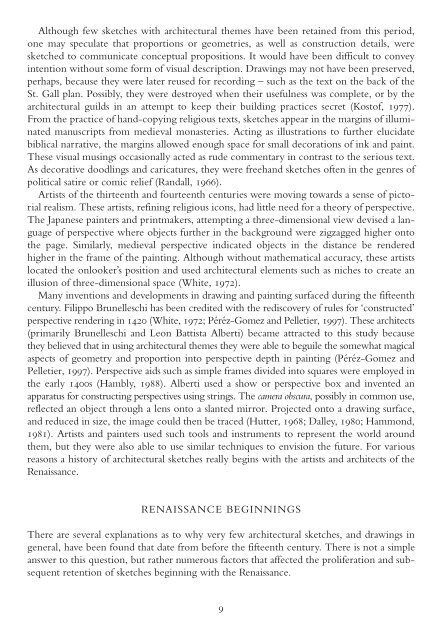Architect Drawings : A Selection of Sketches by World Famous Architects Through History
Create successful ePaper yourself
Turn your PDF publications into a flip-book with our unique Google optimized e-Paper software.
Although few sketches with architectural themes have been retained from this period,<br />
one may speculate that proportions or geometries, as well as construction details, were<br />
sketched to communicate conceptual propositions. It would have been difficult to convey<br />
intention without some form <strong>of</strong> visual description. <strong>Drawings</strong> may not have been preserved,<br />
perhaps, because they were later reused for recording – such as the text on the back <strong>of</strong> the<br />
St. Gall plan. Possibly, they were destroyed when their usefulness was complete, or <strong>by</strong> the<br />
architectural guilds in an attempt to keep their building practices secret (Kost<strong>of</strong>, 1977).<br />
From the practice <strong>of</strong> hand-copying religious texts, sketches appear in the margins <strong>of</strong> illuminated<br />
manuscripts from medieval monasteries. Acting as illustrations to further elucidate<br />
biblical narrative, the margins allowed enough space for small decorations <strong>of</strong> ink and paint.<br />
These visual musings occasionally acted as rude commentary in contrast to the serious text.<br />
As decorative doodlings and caricatures, they were freehand sketches <strong>of</strong>ten in the genres <strong>of</strong><br />
political satire or comic relief (Randall, 1966).<br />
Artists <strong>of</strong> the thirteenth and fourteenth centuries were moving towards a sense <strong>of</strong> pictorial<br />
realism. These artists, refining religious icons, had little need for a theory <strong>of</strong> perspective.<br />
The Japanese painters and printmakers, attempting a three-dimensional view devised a language<br />
<strong>of</strong> perspective where objects further in the background were zigzagged higher onto<br />
the page. Similarly, medieval perspective indicated objects in the distance be rendered<br />
higher in the frame <strong>of</strong> the painting. Although without mathematical accuracy, these artists<br />
located the onlooker’s position and used architectural elements such as niches to create an<br />
illusion <strong>of</strong> three-dimensional space (White, 1972).<br />
Many inventions and developments in drawing and painting surfaced during the fifteenth<br />
century. Filippo Brunelleschi has been credited with the rediscovery <strong>of</strong> rules for ‘constructed’<br />
perspective rendering in 1420 (White, 1972; Péréz-Gomez and Pelletier, 1997). These architects<br />
(primarily Brunelleschi and Leon Battista Alberti) became attracted to this study because<br />
they believed that in using architectural themes they were able to beguile the somewhat magical<br />
aspects <strong>of</strong> geometry and proportion into perspective depth in painting (Péréz-Gomez and<br />
Pelletier, 1997). Perspective aids such as simple frames divided into squares were employed in<br />
the early 1400s (Hambly, 1988). Alberti used a show or perspective box and invented an<br />
apparatus for constructing perspectives using strings. The camera obscura, possibly in common use,<br />
reflected an object through a lens onto a slanted mirror. Projected onto a drawing surface,<br />
and reduced in size, the image could then be traced (Hutter, 1968; Dalley, 1980; Hammond,<br />
1981). Artists and painters used such tools and instruments to represent the world around<br />
them, but they were also able to use similar techniques to envision the future. For various<br />
reasons a history <strong>of</strong> architectural sketches really begins with the artists and architects <strong>of</strong> the<br />
Renaissance.<br />
RENAISSANCE BEGINNINGS<br />
There are several explanations as to why very few architectural sketches, and drawings in<br />
general, have been found that date from before the fifteenth century. There is not a simple<br />
answer to this question, but rather numerous factors that affected the proliferation and subsequent<br />
retention <strong>of</strong> sketches beginning with the Renaissance.<br />
9




